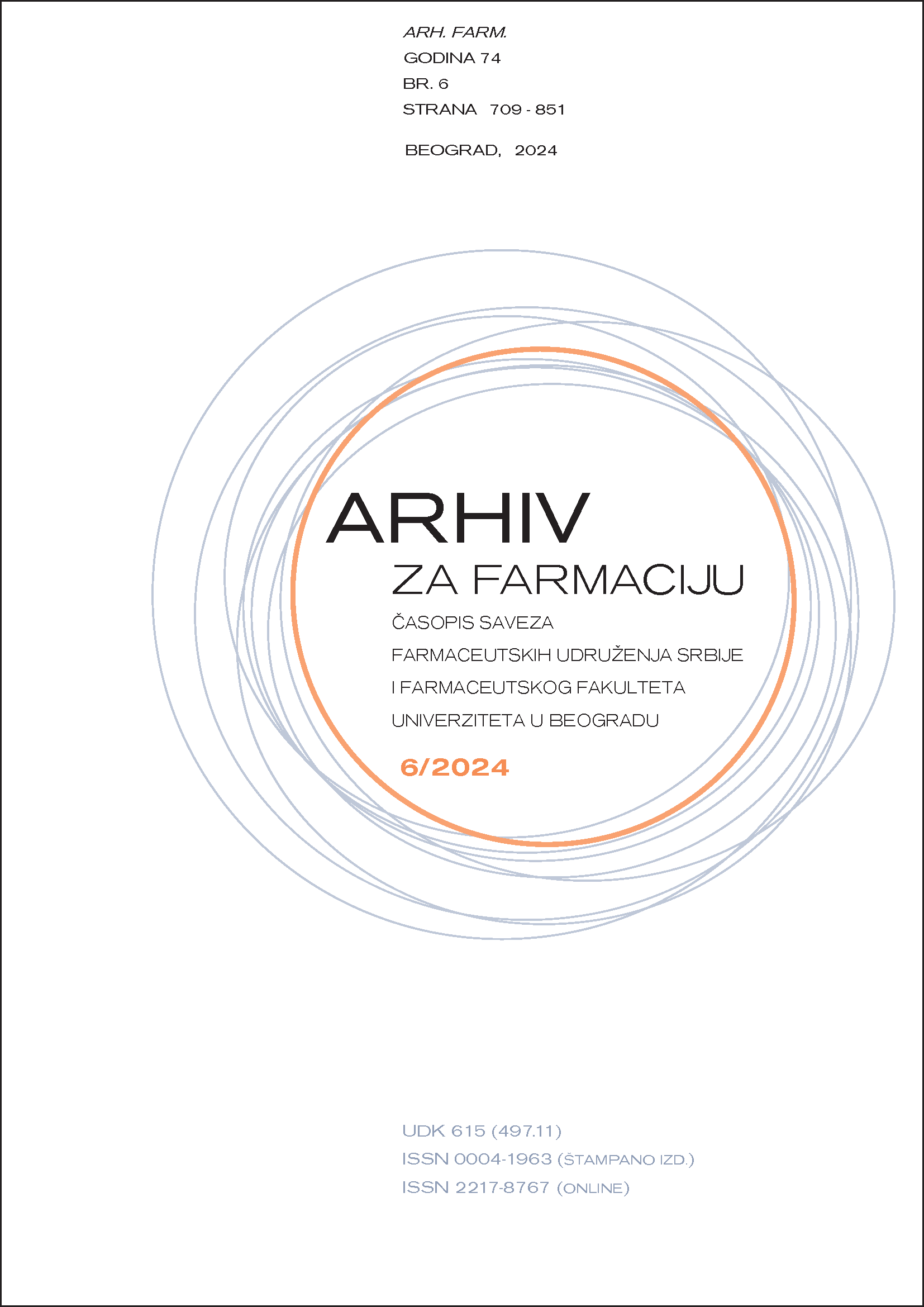Heuristic analysis of structure, activity and selectivity relationships of isocoumarin derivatives as potential antifungal agents
Abstract
A series of recently synthetized and biologically evaluated isocoumarin derivatives (n=16, including voriconazole as standard) were used for heuristic analysis of structure, activity and selectivity relationships. While research of isocoumarins found in the literature was mainly focused on antifungal properties of 3-alkyl/aryl compounds, this study used structures synthetized by a strategy merging antifungal properties of isocoumarins with some known fungal pharmacophores. Rationalization of activity and selectivity was performed using the results of testing against C. albicans (CA) and testing on a normal human lung fibroblast cell line (MRC5). Structures were created and optimized using the ChemDraw Ultra 8.0 and MOPAC software. Calculation of molecular descriptors and the heuristic method, using the Codessa software, were applied for the selection of the most significant descriptors for activity against CA, as well as selectivity against CA versus MRC5. Biological tests for determination of activity against CA used in studies include inhibition of hyphal growth, so the activity against resistant cells was also considered. The supposed mechanisms of action, including lacton opening and electrophilic attack on nucleophiles, as well as inhibition of lanosterol 14a-demethylase (CYP51), were in agreement with the results obtained. The results could serve as a basis for further optimization of isocoumarin derivatives with respect to better activity, selectivity and action against resistant species.
References
Braca A, Bader A, De Tommasi N. Plant and Fungi 3,4-Dihydroisocoumarins. In: Atta-ur-Rahman FRS, editor. Studies in Natural Products Chemistry. Oxford: Elsevier; 2012; p. 191-215.
Alvino Leite MC, De Brito Bezerra AP, De Sousa JP, Guerra FQS, De Oliveira Lima E. Evaluation of antifungal activity and mechanism of action of citral against Candida albicans. Evid Based Complement Alternat Med. 2014;2014:378280.
Wiederhold NP. Antifungal resistance: current trends and future strategies to combat. Infect Drug Resist. 2017:10:249-259.
Simić M, Paunović N, Boric I, Randjelović J, Vojnović S, Nikodinović-Runić J, et al. Functionalised isocoumarins as antifungal compounds: Synthesis and biological studies. Bioorg Med Chem Lett. 2016;26:235-9.
Simić M, Erić S, Borić I, Lubelska A, Latacz G, Kiec-Kononowicz K, et al. Synthesis and biological profiling of novel isocoumarin derivatives and related compounds. J Serb Chem Soc. 2021;86(7-8):639-49.
Newman DJ. Natural products as leads to potential drugs: an old process or the new hope for drug discovery?. J Med Chem. 2008;51:2589-99.
Hampl V, Wetzel I, Bracher F, Krauss J. New substituted isocoumarins and dihydroisocoumarins and their cytotoxic activities. Sci Pharm. 2011;79:21-30.
Kathiravan MK, Salake AB, Chothe AS, Dudhe PB, Watode RP, Mukta MS, Gadhwe S. The biology and chemistry of antifungal agents: a review. Bioorg Med Chem. 2012;20:5678-98.
Hatshemi SM, Badali H, Irannejad H, Shokrzadeh M, Emami S. Synthesis and biological evaluation of fluconazole analogs with triazole-modified scaffold as potent antifungal agents. Bioorg Med Chem. 2015;23:1481-91.
Rostom SAF, Ashour HMA, Razik HAA, Fattah AEFHA, El-Din N. Azole antimicrobial pharmacophore-based tetrazoles: Synthesis and biological evaluation as potential antimicrobial and anticonvulsant agents. Bioorg Med Chem. 2009;17:882-95.
Emami S, Shojapour S, Faramarzi MA, Samadi N, Irannejad H. Synthesis, in vitro antifungal activity and in silico study of 3-(1,2,4-triazol-1-yl)flavanones. Eur J Med Chem. 2013;66:480-8.
ChemDraw Ultra 8.0. CambridgeSoft, 100 Cambridge Park Drive, Cambridge, MA.
Stewart JJP. Mopac Manual, 6th Seiler Research Laboratory, United States Air Force Academy, CO 80840.
Katritzky AR, Lobanov VS, Karelson M. CODESSA, Reference Manual. Version 2.0. University of Florida, FL Gainesville; 1994.
Zhang Y, Dlugosch M, Jübermann M, Banwell MG, Ward JS. Total syntheses of the resorcylic acid lactone neocosmosin A and its enantiomer. J Org Chem. 2015;80:4828-33.
Rostom SA, Ashour MA, Abd HA, Razik EL, Tattah AE, El-Din NN. Azole antimicrobial pharmacophore-based tetrazoles: synthesis and biological evaluation as potential antimicrobial and anticonvulsant agents. Bioorg Med Chem. 2009;17:2410-22.
Saeed A. Isocoumarins, miraculous natural products blessed with diverse pharmacological activities. Eur J Med Chem. 2016;116:290-317.
Emami S, Banipoulad T, Irranejad H, Foroumadi A, Falahati M, Ashrafi-Khozani M, Sharifynia S. Imidazolylchromanones containing alkyl side chain as lanosterol 14α-demethylase inhibitors: synthesis, antifungal activity and docking study. J Enzyme Inhib Med Chem. 2014;29:263-271.
Sagatova AA, Keniya MV, Wilson RK, Monk BC, Tyndall JDA. Structural Insights into Binding of the Antifungal Drug Fluconazole to Saccharomyces cerevisiae Lanosterol 14α-Demethylase. Antimicrob Agents Chemother. 2015;59:4982-9.
Hargrove YT, Friggeri L, Wawrzak Z, Qi A, Hoekstra JW, Schotzinger RJ, et al. Structural analyses of Candida albicans sterol 14α-demethylase complexed with azole drugs address the molecular basis of azole-mediated inhibition of fungal sterol biosynthesis. J Biol Chem. 2017;292(16):6728-43.
Balding PR, Porro CS, McLean KJ, Sutcliffe MJ, Maracheal JD, Munro AW, De Visser SP. How do azoles inhibit cytochrome P450 enzymes? A density functional study. J Phys Chem A. 2008;112:12911-8.
Strushkevich N, Usanov SA, Park HW. Structural basis of human CYP51 inhibition by antifungal azoles. J Mol Biol. 2010;397:1067-78.
Godamudunage MP, Grech AM, Scott EE. Comparison of Antifungal Azole Interactions with Adult Cytochrome P450 3A4 versus Neonatal Cytochrome P450 3A7. Drug Metab Dispos. 2018;46:1329-37.
Pal S, Chatare V, Pal M. Isocoumarin and Its Derivatives: An Overview on their Synthesis and Applications. Curr Org Chem. 2011;15:782-800.
Noble SM, Britany AG, Witchley JN. Nat Rev Microbiol. 2017;15:96-108.
Tammam MA, Gamal El-Din MI, Abood A, El-Demerdash A. Recent advances in the discovery, biosynthesis and therapeutic potential of isocoumarins derived from fungi: a comprehensive update. RSC Adv. 2023;13(12):8049-89.
Costa-de-Oliveria S, Rodrigues AG. Candida albicans antifungal resistance and tolerance in bloodstream infections: the triad yeast-host-antifungal. Microorganisms. 2020;8(2):154-73.

